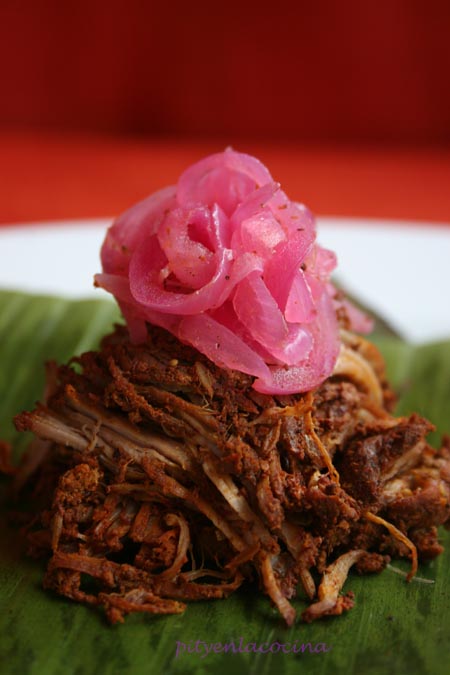
...there in Yucatan…And since then I always remember you and the nights I spent by your side, sharing the moon and lots of dinners. I love everything about you, your colour, your ingredients, and the way you look at me from the plate, almost challenging me. I pile you up, pick you up and gently let you sit on your tortilla and it’s in that very moment when pointing at my mouth, I prepare myself to enjoy what you kindly offer me, without asking anything in exchange. Thanks Cochinita Pibil, thanks, Yucatán, we’ll meet again, hopefully...one day.

Cochinita or Puerco Pibil is a legendary dish, and it’s coked traditionally by wrapping the meat after marinating it for hours, and cooked in a pit on the ground for longer hours, it comes from the Yucatán peninsula, in Mexico. This dish has an important role in Robert Rodriguez’s brilliant movie, Once upon a time in Mexico, where Johnny Depp gets so obsessed with it, that he kills the chefs who cook it too well. You can view Rodriguez’s recipe here, it´s really worth it.
I have cooked this dish according to the way it was served to me in Yucatán, with plantain, and refried beans, as a side dish as well as Pico de gallo and salsa verde, two V.I.S (very important salsas). Cochinita pibil can be served with rice, or just lying on a warm tortilla, don’t forget the pickled onion though!

Ingredients
For the cochinita and the marinade
½ Kilo pork fillet or loin
3 tablespoons Seville oranges
3 tablespoons vinegar
½ tablespoon achiote powder or paste
¼ teaspoon ground cumin
¼ teaspoon Mexican oregano
4 or 5 peppercorns, ground
1 garlic clove
1 or 2 dried pasilla chillies
3 or 4 big Plantain leaves
Method
Toast the chillies, deseed and grind them along with the garlic. Mix the rest of the ingredients except the meat until you get a paste. Add the chilli mix. Prick the meat with a fork and season with salt and pepper. Toast the plantain leaves over the flame, cover an oven tray with it, and put the meat on top, spread the marinade all over it and wrap the meat with the plantain leave forming a closed package, cover with foil and leave overnight in the fridge. The next day, bake the meat still wrapped in the banana leave, at 150 degrees for 4 hours....yes, 4 hours. Once its cooked shred it with a fork and reserve.

For the pickled onion
1 red onion
½ habanero chilli
2/3 orange juice
Salt
Mix all the ingredients and marinade for two hours
For the Salsa verde
2 or 3 green Mexican tomatoes
1 Serrano chili
2 tablespoon fresh coriander chopped
2 tablespoons onion
1/3 cup water
Salt
Method
Blend all the ingredients and reserve.

For the Pico de gallo
1 red tomato chopped
¼ onion chopped
¼ garlic clove
2 tablespoons fresh chopped coriander
½ jalapeno chilli chopped
1 tablespoon lime juice
Salt
Mix all the ingredients and place in a bowl.
For the refried beans
Ingredients
3 cups cooked black beans
2 tablespoon lard or butter
½ cup of the water that was used to cook the beans
Feta cheese (if you can’t find Mexican cheese)
Salt
Method
Mash the beans, chopped the onion very finely and heat the butter or lard in a saucepan, add the onion, and when it start changing colour add the mashed beans along with the beans stock and the salt, and stir constantly. The beans are done when they don’t stick to the saucepan. Sprinkle with grated feta cheese and serve.













